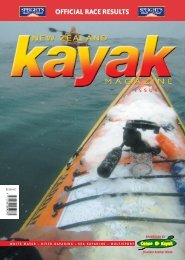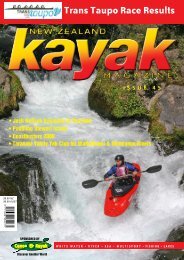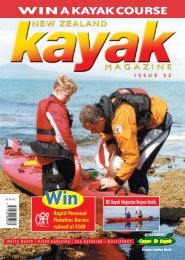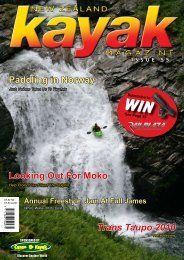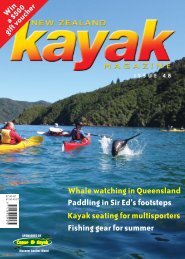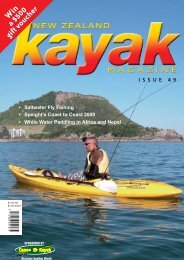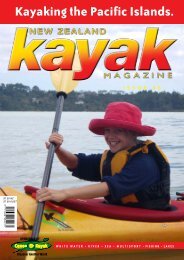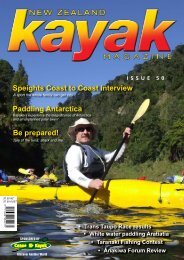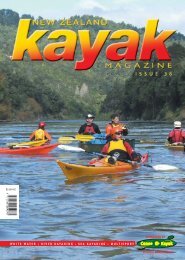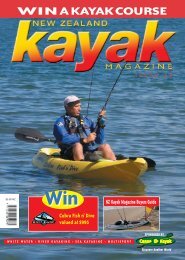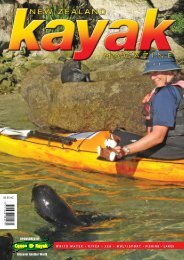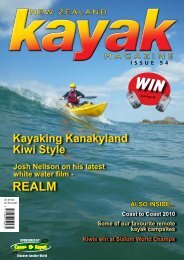Taking on Jeff's Joy Get the Family Kayaking ... - Canoe & Kayak
Taking on Jeff's Joy Get the Family Kayaking ... - Canoe & Kayak
Taking on Jeff's Joy Get the Family Kayaking ... - Canoe & Kayak
You also want an ePaper? Increase the reach of your titles
YUMPU automatically turns print PDFs into web optimized ePapers that Google loves.
Multisport<br />
Eddy<br />
Eddy line<br />
Downstream ‘V’<br />
Fastest line<br />
Eddy line<br />
Upstream ‘V’<br />
Upstream Current<br />
i.e. Eddy<br />
Eddy line<br />
Fastest line<br />
River Flow<br />
Fast lines for River Racing<br />
by Peter Townend<br />
To paddle a river fast you need to recognise where <strong>the</strong> river<br />
current will help, not hinder, you.<br />
It is natural to think of <strong>the</strong> river as a mass of water which reaches <strong>the</strong><br />
sea, but <strong>on</strong> <strong>the</strong> way it is a three dimensi<strong>on</strong>al, massively complex group<br />
of currents heading in different directi<strong>on</strong>s. It <strong>on</strong>ly takes a quick look<br />
in some eddies and you will see <strong>the</strong> same flotsam going around and<br />
around for an age. Or look at a weir type obstacle. Flotsam will stay in<br />
<strong>the</strong> wave area, sometimes forever.<br />
Understanding what causes eddies is probably <strong>the</strong> first step to fast river<br />
kayaking.<br />
How do eddies form?<br />
An eddy forms when flow is impeded by an obstacle such as a rock<br />
or bank. Downstream <strong>the</strong> water level is lower than <strong>the</strong> water hitting<br />
<strong>the</strong> upstream side. Some water flows around <strong>the</strong> obstacle and tries<br />
to fill <strong>the</strong> downstream ‘hole’. Hence an upstream current forms below<br />
obstacles.<br />
How do you see eddies <strong>on</strong> <strong>the</strong> river?<br />
The area where upstream and downstream currents meet is <strong>the</strong> ‘Eddy<br />
line’. When <strong>the</strong> bow of your kayak enters <strong>the</strong> upstream you will slow<br />
down and often spin 180 degrees. When looking down <strong>the</strong> river <strong>the</strong><br />
‘Upstream V’ is <strong>the</strong> shape that ‘Eddy lines’ make ei<strong>the</strong>r side of an<br />
obstacle. The ‘Downstream V’ is <strong>the</strong> shape ‘Eddy lines’ make between<br />
two obstacles in a rapid.<br />
What is <strong>the</strong> best line to take?<br />
A beginner is told to aim for <strong>the</strong> ‘Downstream V’ to avoid obstacles and<br />
<strong>the</strong> Upstream V. This is good advice. However it often means that you<br />
will paddle in rougher water at <strong>the</strong> bottom of <strong>the</strong> rapid. Large waves<br />
almost always lurk at <strong>the</strong> bottom of a big ‘Downstream V’.<br />
A trick is two bits of advice. 1/ Start <strong>the</strong> rapid in <strong>the</strong> Downstream V <strong>on</strong><br />
<strong>the</strong> side from which you’ll exit <strong>the</strong> rapid. This sets you up for step 2/<br />
paddle down <strong>the</strong> side of <strong>the</strong> waves at <strong>the</strong> bottom of <strong>the</strong> ‘Downstream V’<br />
al<strong>on</strong>g <strong>the</strong> Eddy line. This allows for a faster more stable paddle.<br />
Look at any moving water (picture is of a small stream) and you will<br />
see <strong>the</strong>se features. Spend <strong>the</strong> time understanding <strong>the</strong>m and you will be<br />
faster, happier, drier and enjoy your kayak racing a heap more.<br />
18 ISSUE FIFTY Three • 2 0 0 9<br />
www.kayaknz.co.nz



